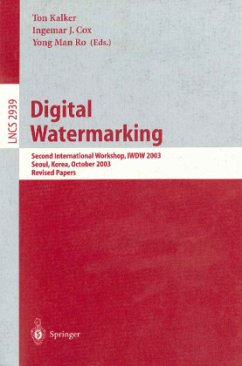This book constitutes the thoroughly refereed postproceedings of the Second International Workshop on Digital Watermarking, IWDW 2003, held in Seoul, Korea, in October 2004.
The 44 revised full papers presented together with 4 invited articles were carefully selected during two rounds of reviewing and improvement from more than 90 submissions. The papers address all current aspects of digital watermarking, in particular theoretical modeling, robustness, capacity, imperceptibility and the human perceptual system, security and attacks, watermarking systems and implementations, and integration of digital watermarking in digital rights management.
We are happy to present to you the proceedings of the 2nd International Workshop on Digital Watermarking, IWDW 2003. Since its modern re-appearance in the academic community in the early 1990s, great progress has been made in understanding both the capabilities and the weaknesses of digital watermarking. On the theoretical side, we all are now well aware of the fact that digital waterma- ing is best viewed as a form of communication using side information. In the case of digital watermarking the side information in question is the document to be wat- marked. This insight has led to a better understanding of the limits of the capacity and robustness of digital watermarking algorithms. It has also led to new and improved watermarking algorithms, both in terms of capacity and imperceptibility. Similarly, the role of human perception, and models thereof, has been greatly enhanced in the study and design of digital watermarking algorithms and systems. On the practical side, applications of watermarking are not yet abundant. The original euphoria on the role of digital watermarking in copy protection and copyright prot- tion has not resulted in widespread usage in practical systems. With hindsight, a n- ber of reasons can be given for this lack of practical applications.
The 44 revised full papers presented together with 4 invited articles were carefully selected during two rounds of reviewing and improvement from more than 90 submissions. The papers address all current aspects of digital watermarking, in particular theoretical modeling, robustness, capacity, imperceptibility and the human perceptual system, security and attacks, watermarking systems and implementations, and integration of digital watermarking in digital rights management.
We are happy to present to you the proceedings of the 2nd International Workshop on Digital Watermarking, IWDW 2003. Since its modern re-appearance in the academic community in the early 1990s, great progress has been made in understanding both the capabilities and the weaknesses of digital watermarking. On the theoretical side, we all are now well aware of the fact that digital waterma- ing is best viewed as a form of communication using side information. In the case of digital watermarking the side information in question is the document to be wat- marked. This insight has led to a better understanding of the limits of the capacity and robustness of digital watermarking algorithms. It has also led to new and improved watermarking algorithms, both in terms of capacity and imperceptibility. Similarly, the role of human perception, and models thereof, has been greatly enhanced in the study and design of digital watermarking algorithms and systems. On the practical side, applications of watermarking are not yet abundant. The original euphoria on the role of digital watermarking in copy protection and copyright prot- tion has not resulted in widespread usage in practical systems. With hindsight, a n- ber of reasons can be given for this lack of practical applications.








